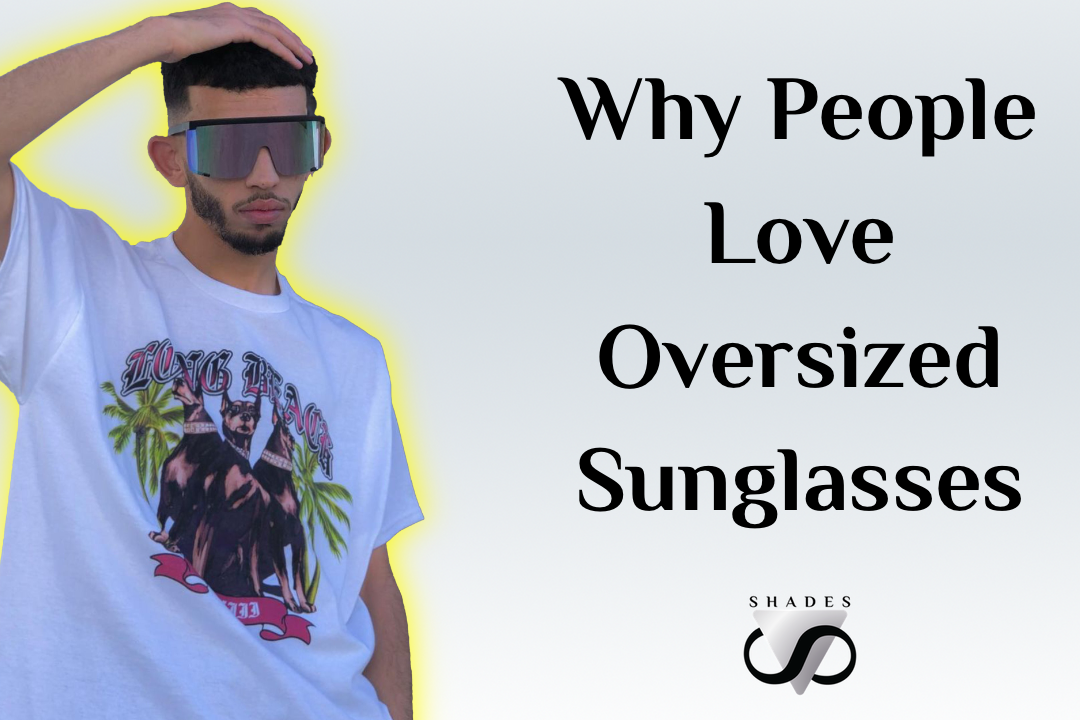Sunglasses with Photochromic Lenses Explained

Photo by Ali Madad Sakhirani
The world of eyewear has seen remarkable advancements over the decades, but among them, photochromic lenses stand out as an innovative solution. Often referred to as light-adaptive or variable tint lenses, these lenses seamlessly adapt to changing light conditions. If you've ever wished for glasses that conveniently switch between clear lenses indoors and sun-tinted lenses outdoors, photochromic lenses might be the answer.
What are photochromic sunglass lenses?
Photochromic lenses, popularly known as transition lenses due to the prominent brand, Transitions Optical, are specially crafted to automatically darken when exposed to ultraviolet (UV) rays and clear up in the absence of them. This makes them especially useful for those frequently transitioning between indoors and outdoors. Originating from Corning Glass Works Inc. in the 1960s, they represented the first variable tint/photochromic lenses introduced to the market.
Photochromic Lenses vs. Transition Lenses
While many people use the terms interchangeably, it's essential to understand that photochromic refers to the lens technology that allows for the change in tint. In contrast, "Transition" refers to the leading brand name of photochromic lenses in the US. So, while all Transition lenses are photochromic, not all photochromic lenses are from the Transitions brand.
Photochromic Lenses vs. Polarized Lenses
Photochromic and polarized lenses serve different purposes. While photochromic lenses adjust their tint based on light exposure, polarized lenses reduce glare from surfaces like water, roads, and cars. It's possible, though uncommon, to find sunglasses that combine both these features – offering adaptability in tint and reducing glare.
Do photochromic lenses get as dark as sunglasses?
While photochromic lenses offer significant darkening in bright sunlight, they might not achieve the full darkness some sunglasses provide. For those needing deeper tint for specific activities or conditions, a dedicated pair of sunglasses might still be necessary.
Can you wear photochromic lenses all the time?
Absolutely! The light-adaptive nature of photochromic lenses makes them ideal for continuous wear. They adjust to indoor and outdoor lighting, offering clear vision and UV protection. This adaptability eliminates the need to switch between regular glasses and sunglasses, making life more convenient.
How long do photochromic sunglasses last?
The lifespan of photochromic lenses generally aligns with the duration of a prescription. Plastic photochromic lenses can outlast the usual prescription term, which is about 2.5 years. Interestingly, glass photochromic lenses improve with age and retain their darkening ability throughout their life.
Are photochromic sunglasses good for driving?
Yes, photochromic lenses can enhance safety while driving. They adjust to changing light conditions, ensuring optimal vision whether you're driving during the day or at night, providing protection against bright sunlight and UV rays.
Are transition glasses for old people?
Transition lenses, with their ability to adjust to varying light conditions, aren't exclusive to any age group. They are as suitable for children, who might find managing multiple pairs challenging, as they are for adults. The convenience and functionality they offer make them a universal choice, regardless of age.
Conclusion
Photochromic or transitional lenses have revolutionized the way we perceive eyewear. By merging the benefits of regular glasses and sunglasses, they offer a cost-effective and functional solution for many. Whether indoors, outdoors, or on the road, these lenses ensure that you're always seeing the world in the best light. If you find yourself frequently transitioning between different lighting environments, photochromic lenses might just be the perfect eyewear solution for you.

Australian Model Spencer Cranston (right) wearing ‘Signature 01 - Revo Lens’ by V SHADES for Male Basics Underwear in Twisted Male Magazine
Models Bryson Elliot, Hayden Semeniuk and Jackson England each strike a hot beach pose while posing in V SHADES and Sukrew Swimwear in Australia.
Australian model Hayden Semeniuk rocks a blue Sukrew speedo and ‘Crush’ Small Round Gradient Lens Lennon Sunglasses by V SHADES.
Moroccan fashion model, Yassine Zarrab, dons a swagged-out street style look that features a black ski mask, a stylish half-zip jacket and ‘Boss’ Oversized Shield Sunglasses by V SHADES.
Model Sarvar looks ultra stylish in a plush black hoodie and ‘Lounge’ Black Square Fashion Sunglasses by V SHADES.
Model Yassine Bettari rocks a trendy laid-back look that features gray sweat pant joggers, a black and gray letterman-style jacket, white Air Force 1 sneakers and B.B.E. Oversized Shield Square Sunglasses by V SHADES.
Moroccan Model Oussama Dahhou sports an all-black futuristic streetwear look that features a puffy leather jacket, a black tee, trendy cargo pants, nike tennis shoes and ‘Motorsport’ Oversized Shield Sunglasses by V SHADES.
Australian Model Kyle Ahchak sports a casual look that features blue cargo joggers, a fire graphic tank top and ‘Tour’ Tortoise Navigator Sunglasses by V SHADES.
Fashion Influencer Ismail Bahaoui dons a futuristic look that features a trendy navy blue jacket and ‘Boss’ Oversized Shield Gradient Lens Sunglasses by V SHADES.
Style influencer Yasser Marzouk created a stylish streetwear look that features a black hoodie, a letterman jacket, a gold necklace and ‘Soul’ Square Wood Sunglasses by V SHADES.
Moroccan style influencer Youness Anou looks super stylish in this streetwear look that features loose-fitting black pants, trendy high-top sneakers, a graphic tee and ‘Free’ Cat Eye Sunglasses by V SHADES.
Moroccan influencer Wail Moumena rocks a casual and sleek outfit that features a long sleeve black shit and ‘Teach’ Black Frame Blue Light Glasses by V SHADES.
Moroccan fashion model Oumaima Ait Ali creates a trendy black and white look by pairing oversized plaid outerwear with Black Cat Eye Sunglasses by V SHADES.
Moroccan Style Influencer Omar Aguerouach dons a dope streetwear look that features a green sweatsuit with white stripes along with a matching hat, trendy tan high-top sneakers, ‘Blaze’ white and gold cat eye sunglasses by V SHADES.
Fashion influencer Omar Ouaatou sports a casually stylish fit that features blue jeans, a white crew neck hoodie, white tennis shoes and ‘Tech’ Double Bridge Fashion Glasses by V SHADES.
Model Fatima Zahra (right) oozes beauty in this vibrant shot wearing khacki trousers, a black and off-white zebra top under a cream leather jacket, and ‘Blaze’ Cat Eye Sunglasses by V SHADES.
Fashion influencer Hasni Khicha dons a stylish casual look that features plaid outerwear over a black Palm Angels shirt, a silver wristwatch, an “H” chain letter necklace, a black beaded bracelet and ‘Treasure’ Rimless Sunglasses by V SHADES.
Moroccan model Hamzaa Ouijjane sports a trendy look that features green cargo pants, a black graphic tee, a silver chain necklace, a silver watch and ‘Blue-Ray’ Rounded Square Blue Light Glasses by V SHADES.
Moroccan style influencer Hamza Laabi is no stranger to putting together trendy looks.He’s seen here wearing graphic cargo pants, black sneakers, a graphic tee under a bright red bomber jacket and ‘Boss’ Oversized Shield Sunglasses by V SHADES.
In a collaboration with Photographer Seth London via Talent Manager Ryan Colby, actress Fiviona Pham raises the bar on how to style round fashion sunglasses. She’s spotted here wearing a flowing woven top accessorized with ‘Cirque’ Round Metal Frame Sunglasses by V SHADES.
Albanian Style Influencer Erida Hoxha looks glamorous while taking a stroll wearing an orange blouse, black trousers, and 'Chic' Fashion Chain Arm Sunglasses by V SHADES.
American beauty influencer Tesha Adderley showcases her top-notch style in a graphic black and white blouse paired perfectly with 'Time' Black Frame Cat Eye Sunglasses by V SHADES.
Model Rony Augustin took a page from the vintage book of styling in the above shot from a photoshoot that landed in Loike Homme Magazine. Augustin chose pair a pin-striped blazer with black trousers and ‘Crush’ Small Round Metal Frame Lennon-Style Sunglasses by V SHADES.
Moroccan Style influencer Houssam Sekkaf rocks a streetwear look that includes black and white basketball shorts, a graphic hoodie, Air Jordan Sneakers, a chunky silver necklace, a Kavanagh hat and ‘Surge’ Square Fashion Reflective Sunglasses by V SHADES.
Moroccan model and style influencer Mohamed El Mounim knows exactly how to strike the perfect balance between luxury and street style! He’s spotted here sporting cargo pants, trendy white sneakers, a white tee shirt under a light-colored sherpa jacket and ‘Switch’ Rimless Tinted Lens Sunglasses by V SHADES in purple.
Model Rony Augustin looks super fly in this shot by Photographer Seth London. His outfit features an open pin-striped jacket, navy trousers, an oversized pea coat, a patterned headband, dangling ear jewelry and 'Crush' Small Round Lennon-Style Sunglasses with Gradient Lenses by V SHADES.
Albanian style influencer Anisa Dobra pulls off a casual fashion look that features a button-down collared dress, white sneakers and Black Frame Cat Eye Sunglasses by V SHADES.
Filipino style influencer Jelo Villanueva looks nothing short of stunning in this all-black fit that features ‘Thrill’ Rectangle Cat Eye Sunglasses by V SHADES.
Moroccan fashion influencer Mohamed Akhabar looks too cool in this stylish shot where he’s seen wearing a horizontal striped short sleeve button-down shirt, denim pants, and ‘Big Life’ Oversized Shield Sunglasses by V SHADES.
In this chic look, Albanian Style Influencer Fatjona Hysi pairs a high-waisted skirt with a black crop top, a black blazer and accessorizes it all with a leather snakeskin purse topped off with 'Gorgeous' Cat Eye Sunglasses by V SHADES.















































































